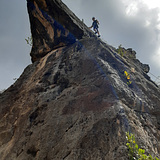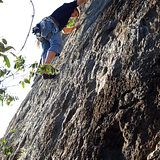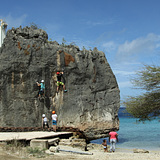Climate: it’s best to climb either early in the morning or late in the afternoon. Use sunscreen. If you’re in the area around mid-day, consider to go for a swim to cool down.
Protection (tech stuff): all bolts are 110mm Eterna bolts, made out of titanium alloy, to provide long bolt life in the highly corrosive environment of our tropical sea climate. The bolts of “Unchained” were glued with Fischer EM-390, all other bolts were glued with Hilti RE-500. Most anchors have two bolts with quick links and a ring. Some anchors are “U” bolts with a ring. These should be sufficient when used as an anchor. Often, there will be another anchor or bolt nearby if you want to back it up.
Equipment: a climbing rope of at least 30 meters. 6 quickdraws, a sling and 2 carabiners for the top anchor.
Rock: the rock is coral limestone; very sharp in places, and sometimes a bit brittle.
Plants: beware of various cacti and the thorny wabi plant. They easily penetrate soles of shoes or ‘grab’ your shirt. Manzanilla trees are not common in the area.
Parking: by the side of the road. When your leave your car, don’t leave your belongings in sight! The area is notorious for car burglaries.
In the summer of 2017, an opportunity presented itself to me to move to Curaçao. The intent was to settle permanently. When in such a position, one starts asking important questions. One of my primary questions was (of course): is there any rock climbing on Curaçao?
Initially, I was pessimistic. I had never been there, but the island was known for beaches and water sports, not climbing. In the region, I had only heard about the Grapefield climbing area on Aruba. Googling “climbing curacao” resulted in a couple of Youtube videos of improvised bouldering and climbing. There were no bolted climbing areas or guidebooks.
For me, the conclusion was logical. If I wanted to climb on Curaçao, I needed to develop climbing myself. I started to look for suitable areas. It quickly became apparent that there are plenty of rocks on Curaçao. However, most of the time, it seemed unaccessible. Photos are not enough to get any impression of rock quality. Except for the Fort Beekenburg area. Close to the road, its popularity with tourists meant there were many photos online. Especially the rock formation now known as the “Chain block” peeked my interest.
In the fall of 2017, in exchange for a donation, I learned bolting from Kobe Bellinkx of the Belgian Rebolting Team. Then, I then bought 12 bolts and 3 anchors from titanclimbing.com (expensive but durable in the tropical sea climate) and put them in a container. With this, I thought, I could create three routes for my own enjoyment. Such was the scale of my thinking back then.
Early in 2018, I moved to Curaçao. Most of that first year was pretty chaotic due to developments in business and private life. I was glad to learn that Rock Climbing Curaçao (RCC) was already developing climbing areas. Roi Rincon was nice, but when I saw photos of Piscadera for the first time I remember experiencing a sense of salvation – here was a climbing area that resembled the likes of which I would visit on climbing trips abroad.
An important milestone was that Stichting Uniek Curaçao granted permission to develop the Fort Beekenburg climbing area. Furthermore, the Nederlandse Klim- en Bergsport Vereniging (NKBV – the Dutch mountaineering association) got wind of my plans and graciously donated a very large number of bolts.
In the final quarter of 2018, I rebolted “Unchained”. This old aiding line contained horribly rusted improvised wedge bolts. After that, development was halted for a while because I had to figure out a suitable option for fixing the glue bolts, that was available locally. This came to a close when I learned about Caribbean Fasteners, a company that sells Hilti RE-500. To this day, they sponsor the development of rock climbing by giving discounts.
Late spring 2019, I learned that my good friends Howard and Ezra would come to visit Curaçao in the fall. And I thought, wouldn’t it be nice if I can take them climbing in an area that I have developed myself…? This resulted in the execution of phase 1. It started in the summer of 2019 and lasted until Christmas. During that time, I spent a morning each week to plan, prune, clean, drill, glue bolts and testing; and make this free e-guidebook. For me personally, it was a learning experience: pacing myself because of the heat, dodging thorny vegetation and rigorously applying sun screen. Local climbers pitched in a lot. It was good to have help from people who were knowledgeable about the local vegetation. Without, I would probably have skipped the development of “The Prow – Gully Side”, which now is the most popular sector of the area. The result of phase 1, in December 2019, was 19 routes, of which 5 were “topropes” employing anchors of other routes or natural anchors.
In the fall of 2019, with the help of Ezra and Howard I enjoyed the new routes. However, we also scouted the Kabrietenberg North face, a taller wall nearby. Initially, I planned to take a long break from bolting after finishing phase 1. My break lasted about 2 weeks. Then, I started working again on a weekly basis to develop the Kabrietenberg climbing area; more challenging because of its remoteness, height and interruptions caused by Covid-19.
In the meantime, the Fort Beekenburg climbing area got a lot of attention, primarily because of its close proximity to the road. The area became steadily more popular, especially with beginners and lovers of moderate climbing. Therefore, end of November 2021, I executed a “blitz” style project to realize phase 2 of the development. After preparations, I took a week off and added 5 new routes. I also bolted 4 toprope projects. This very ambitious project could only be completed in such a short time because of the help of local climbers. Looking at the grades of the new routes, the additions are balanced; but the bolting of existing topropes focused on the harder routes.
What the future holds in store is unknown; is it ever... Further development of the area is possible, but if this happens it will probably be on as yet undeveloped rock formations. There are many nearby.
For the development of the area a big thank you goes to: Kobe Bellinkx and Wim Wouters of the Belgian Rebolting Team, for teaching me how to bolt and their priceless follow-up advise. Natasha Verstappen and Terence Ching, for being my link to the developing local climbing community and arranging access for development. Harald Swen and Robin Baks, for donating high-quality bolts. Without your donations, it would not have been possible for me to take development to this scale. The Korsou Bolting Team: Bernice Falconi, Imma Curiel, Claudio da Silva Correa, Shannon Ray, Ingmar Schnitzler, Shirley Roest van Dongen, Jaimie van Dongen, Rob van Wageningen, Andy Wilson, Lyangelo Vasquez and Matthijs de Bruin… for helping me to develop the climbing area and raise funds. Milan Schunselaar and Martin Roberts, for their support with materials and knowledge. Everyone who attended the belay Sunday fundraising events; transported bolts for me from the Netherlands; and all climbers who provided feedback and bought the collector’s edition of the guidebook. And everyone I forget to mention.
Thank you! Stefan van der Leede





